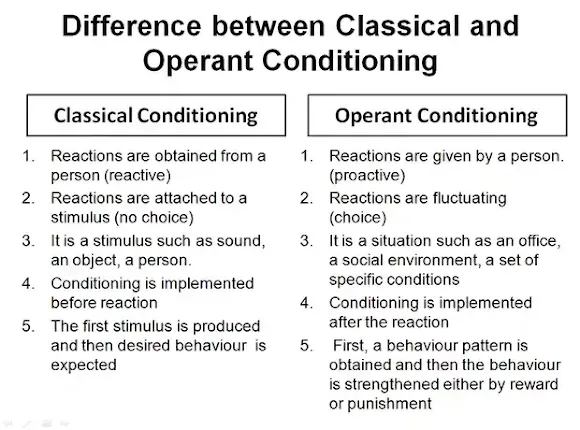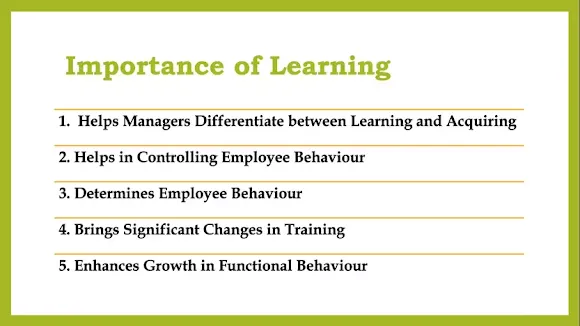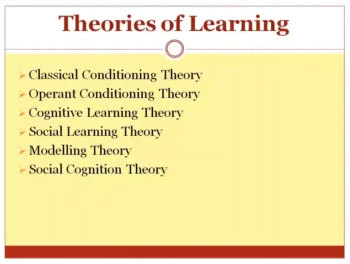Table of Contents:-
- Theories of Learning
- Importance of Theories of Learning
- Managerial Implication of Theories of Learning
Theories of Learning
Many theories have evolved to describe the different aspects of learning. These theories of learning are as follows:

Theories of Learning
- Classical Conditioning Theory
- Cognitive Learning Theory
- Operant/ Instrument Conditioning Theory
- Social Learning Theory
Classical Conditioning Theory
This theory explains that an individual usually reacts differently to a certain stimulus than he would not react to a normal stimulus. A Russian physiologist named Ivan Pavlov conducted several experiments to train dogs to salivate after hearing the ring of bells. Pavlov used a simplistic logical mechanism to measure with utmost accuracy the amount of saliva secreted by the dog.
Pavlov experiment
In this experiment, Pavlov showed a piece of meat to the dog and then he noticed that there was a substantial increase in salivation in the dog’s mouth. When Pavlov rang the bell but did not give meat to the dog, the dog did not secrete saliva from his mouth.
Then, Pavlov came up with a new idea of linking the ringing of the bell and giving meat. After that, the dog became habituated to the ringing of the bell. As a result, no sooner did the bell ring, than the dog began to secrete saliva. Then, gradually the dog became habitual to this phenomenon, and whenever the bell rang it would salivate even if there was no meat offered. As an outcome of the experiment, the dog had become accustomed to responding to the stimulus, i.e., salivating to the sound of the bell.
The meat piece was just an unconditional stimulus to the dog, and the reaction on the dog’s part was the unconditioned response. The bell acted as an artificial or conditional stimulus, as termed by the people. So, the last, conditioned response is the key concept. This portrays the behaviour of the dog, i.e., the ringing of the bell acted as a stimulus and the dog salivated in reaction to the sound of the bell.
Classical conditioning theory is shown in the figure:

Classical conditioning helps in understanding human behaviour effectively. An important form of classical conditioning is higher-order conditioning in which a conditioned stimulus having the ability to develop a conditioned response may be used as the unconditioned stimulus. As higher-order conditioning for learning by human beings is important, its application should be improved. For example, higher-order conditioning explains how to link learning with stimuli. The other application of higher-order conditioning is that it helps in the achievement of reinforcement.
Operant/Instrument Conditioning Theory
Operant conditioning involves rewarding an intended behaviour or avoiding disciplinary action. The behaviour of people is motivated by something that they want or something that they want to avoid. Operant behaviour is intended or learned behaviour, unlike reflective or unlearned behavior. This repetition of learned behaviour is because of its reinforcement or even by repeating avoidance of unwanted behaviour. Thus, reinforcement helps in repetition and strengthening the learned behaviour.
Related Article:- Nature of Organisational Behaviour
Research for operant conditioning was carried out by Harvard psychologist B.F. Skinner. Skinner believed the positive outcomes of behaviour increase its frequency of repetition. If people are sure that they will get positive results, they will engage themselves in that sort of behaviour, Rewards have a useful impact if they are given instantly after the desired result. It should be kept in mind, that the behaviour lacking reward, or pro to punishment, has very little chance of repetition.

Examples of operant conditioning are found everywhere in our day-to-day lives. A simple example of operant behaviour is the application of brakes by the driver of the vehicle to prevent accidents. In this case, the encouraging situation is that by the application of brakes, the possibility of an accident is avoided. So, in this scenario, the application of brakes is the behaviour and avoidance of accident is the reaction to that behaviour. Human beings can judge which behaviour is good and rewarding and follow up on those behaviours in their day-to-day lives for their well-being by using the operant conditioning mechanism.
Difference between Classical and Operant Conditioning

Cognitive Learning Theory
Cognitive theorists lay more stress on the significance of perception, problem-solving and intuition rather than believing that learning acts as the bridge between stimulus and response. This view truly points out that learning is not only an outcome of trial and error or practice, but it is also the exploration of meaningful patterns that enable the learner to find a solution to the problem.
Cognitive learning usually includes learning facts, notions, viewpoints, and information that enhance our ability to reason, solve problems and learn relationships. It avoids direct experience or reinforcement. Thus, cognitive learning has a wide scope, i.e., it can vary from simple information procurement to more complicated and imaginative problem-solving.
The image given below elaborates some conclusions about cognitive learning:

Step 1: This view states that generally people learn from their experiences and use previous learning as the foundation for their existing behaviour. These experiences are a symbol of knowledge or understanding.
For example, an employee facing a dilemma in choosing his project will rely on experience while making the decision.
Step 2: People are generally inclined towards choosing the right behaviour. The employee has a notion that he has two options to select from and he chooses the more suitable one for attaining knowledge.
Step 3: People are generally well aware of the result of their choices. Thus, when the employee gets the preferred project which is both rewarding and fulfils the criteria of his satisfaction, he or she concludes that the choice was a wise one. He would also understand the reason behind it.
Step 4: People analyse those results and connect them with their previous knowledge. This becomes a guide for their future endeavours. In the times to come, if the same type of project arises again, the employee will have a preference for the same.
Social Learning Theory
The social learning theory is a social behavioural approach that lays stress on the correlative synergy between intellectual, behavioural and conditional factors of human behaviour, social learning theory which is also known as observational learning usually happens when an observer moulds his behaviour after observing or attentively examining the model’s behaviour.
The behaviour of an observer is greatly influenced by the positive or negative results known as vicarious reinforcement or vicarious punishment, which are part of the model’s behaviour. People acquire knowledge either through observation or by directly experiencing it.
A person acquires knowledge mostly by keenly observing the behaviour of models whom he admires, from counsellors who advise them, colleagues ist the workplace, theatre and television actors, superiors who supervise his actions, etc.
This theory is an extended form of operant conditioning, ie, it has a presumption that behaviour is the result of consequences. It also recognises the presence of knowledge through observation of others’ behaviour and the significance of perception that forms a part of the learning process. Two important social learning theories are modelling theory and social cognition theory.
Modelling Theory
The social learning theory formulated by Bandura lays great stress on the observation and modelling of the behaviours, attitudes, and emotional outbursts of others. Modelling is the process in which the behaviour of others is copied. Sometimes, there is a change in the behaviour of workers the worker may copy a distinct style of a model, or he may copy the behaviour of an observed individual.
For example, a young executive might imitate dressing like his CEO or a junior might like to smoke or drink in the same manner as his superior or manager does. If positive results are originating from observation, the observer would opt for it. Generally, people who are energetic and successful become role models for others.
As stated by Bandura, learning would be time-consuming and full of risks, if people depend only on the impact of their activities to decide their future course of action. But luckily, human behaviour is mostly learned by observing others’ behaviour. An individual gets a notion about the new behaviour to be performed through observation, and this concealed information ultimately results in subsequent actions.
There are four processes, through which a model influences an individual. These are as follows:
1) Attention Process
People can learn from models only when they pay attention to the model’s traits. People are greatly influenced by models possessing charming and pleasing personalities, who are socially and readily available and have the desired characteristics.
2) Retention Process
A model’s influence can be judged by analysing how much an individual remembers about the model in their absence.
3) Motor Reproduction Process
When a person observes a model and notices a new pattern of behaviour, then the person should practically implement it. This process of implementing the observed behaviour shows that the person can perform the activities learned from the model.
4) Reinforcement Process
If there is a provision to provide positive perks or rewards, people will willingly exhibit the acquired behaviour. This means that if acquired behaviour is supported affirmatively, the learner would perform it regularly.
Social Cognition Theory
Vygotsky developed the social cognition learning model. This model emphasises that the foundation of individual growth originates from culture. Vygotsky assumed that children’s thinking is primarily influenced by their knowledge about social community (which is learned either by professional or psychological mechanisms).
Vygotsky advocated the use of language for accumulating this knowledge. People can teach the child about the culture using language only. So, language is an essential medium for gaining cultural knowledge.
Culture contributes in two ways to the psychological progression of a child:
1) Culture helps children to acquire knowledge.
2) The existing culture equips children with the tools of thinking. Vygotskian named these tools intellectual adaptation.
The social cognition learning model states that culture inculcates both ways of introspection in children, i.e., what to introspect and how to introspect. Children are more prone to learning through communication. Therefore, educational timetables should be designed in such a way that emphasis should be laid on the synergy between the learners and the tasks which are to be learned.
A child quite often undergoes a situation in which he is unable to perform tasks on his own, but if an adult assists him in his endeavours, the tasks are performed effectively. Keeping this in mind, the process of scaffolding is applied in teaching.
Scaffolding means a range of instructional techniques which are used to direct the child gradually towards effective understanding and, ultimately, better independence in the learning process. It not only helps in delivering instant outcomes but also inculcates the children with the required skills for solving problems independently.
Importance of Theories of Learning
Importance of Learning: Learning is an important process as it helps in making knowledgeable behavioural changes in individuals and societies.
It is also significant for organisations due to the following reasons:
1) Helps in Controlling Employee Behaviour
Learning helps organizations in controlling the behaviour of the employees at the workplace.
2) Determines Employee Behaviour
It assists managers in recognising the level to which learning can be applied to the behaviour for the growth of employees as well as the organisation.
3) Helps Managers Differentiate between Learning and Acquiring
Learning helps managers to distinguish whether a skill is being learned or acquired. Thus, managers can determine that the skill is an acquired one or that the employee is naturally gifted with that skill.
4) Brings Significant Changes in Training
Learning brings about significant changes in the training of employees. It helps managers in the maximum development of talents and abilities of an employee for efficient performance at the workplace.
Related Article:-
5) Enhances Growth in Functional Behaviour
To achieve organisational goals, managers act as educators. They give instructions to the employees to engage themselves in such behaviours which help in the achievement of organisational objectives. They also control and manage unwanted behaviours like absenteeism, carelessness, and disorderliness and encourage the development of purposeful behaviours by giving adequate reviews and benefits.

Managerial Implication of Theories of Learning
Some specific managerial implications of learning theories are as follows:
1) Motivation
Motivation is related to learning in many ways. The extent to which valued rewards follow high performance, for example, will affect an employee’s willingness to work hard in the future, and the cause-and-effect linkage needs to be clear. That is, employees should recognise that certain behaviours (such as hard work) cause certain outcomes (desired rewards) Similarly, If rewards do not follow performance, the employee may be less inclined to work hard in the future.
Related Article:-
2) Performance Evaluation and Rewards
Learning also links up with organisational practices in the performance evaluation and reward system. Performance evaluation is how managers assess the work behaviour of individuals and groups, rewards are the positive reinforcements (salary, promotion, public recognition) that companies give for desirable behaviour.
3) Training
Learning is the basic purpose of employee training. Many organisations devote vast resources to training and development to expand the skills and abilities of their employees.
4) Employee Discipline
Every manager will, at some time, have to deal with an employee who drinks on the job, is insubordinate, steals company property, arrives consistently late for work or is involved in similar problem behaviours.
Managers will respond with disciplinary actions such as written warnings, oral reprimands, and temporary suspensions. But our knowledge about punishment’s effect on behaviour means that the use of the method carries costs. It may produce only a short-term solution and may have serious side effects.
Training employees for unacceptable behaviours only tells them what to do and what not to do. It does not tell them what alternative behaviours are favoured. The result is that this form of punishment frequently leads only to short-term suppression of undesirable behaviour, not to its elimination. Continued use of punishment, rather than positive reinforcement, also leads to produce fear of the manager.
As the punishing agent, the manager becomes associated in the employee’s mind with unfavourable results. Employees respond by “hiding” from their manager. Hence, the use of punishment can weaken manager and employee relations.
5) Creating Mentoring Programmes
Many companies introduce mentoring programmes to facilitate skill development within the workplace. In mentoring a mentor takes the employee under his or her wing and provides advice and guidance on how to survive and get ahead in the organisation. It ensures the transfer of knowledge, skills and expertise between mentor and employee.
Mentoring of course is not restricted to managerial ranks. Union apprenticeship programmes, i.e., do the same by preparing individuals to move from unskilled apprentice status to that of the skilled artisan. A young electrician apprentice typically works under an experienced electrician for several years to develop the full range of skills and abilities required to effectively perform his job.
6) Self-Management
Organisational forms of learning thoughts are not limited to managing the behaviour of others. These concepts can also be used to allow individuals to manage their behaviour and, in so doing, reduce the need for managerial control. This is called self-management.
Self-management requires an individual to deliberately manipulate internal processes, stimuli, and responses to achieve personal behavioural results. The primary methods involve observing one’s behaviour, comparing the behaviour with a standard, and rewarding oneself if the behaviour meets the standard.
7) Other Organisational Implications
Besides motivation, performance evaluation, performance appraisal and rewards, and training, there are still other implications that can be drawn from learning theory:
i) Explain Certain Forms of Managerial Behaviour Towards Subordinates: Learning theory can explain certain forms of managerial behaviour toward subordinates. Suppose a manager always gives bad news to subordinates in a certain way. If the subordinates receive the news constructively and graciously, they are giving the manager positive reinforcement, so he will probably use the same mode of delivery in the future.
ii) Underscore the Manager’s Role: Many aspects of the learning process underscore the manager’s role as a teacher and the subordinate’s role as a learner.
iii) Influences the Day-To-Day Interactions: Learning processes influence the day-to-day interactions, both official and casual, between people in organisations. Almost everything we do in responding to others has reinforcing results for them.
Related Questions:-
What are the four theories of learning?
What are the principles of cognitive learning theory?
What is operant conditioning theory of learning?
What are the 5 principles of social learning theory?
You May Also Like:-
Nature of Organisational Behaviour
Conceptual Foundation of Organisational Behaviour
Contributing Disciplines to organisational behaviour
Models of Organisational Behaviour
Approaches of Organisational Behaviour
Emotional Intelligence in Organisational behaviour
Factors Influencing Perception
Scope of Organisational Behaviour
Importance of Organisational Behaviour
Challenges and Opportunities of Organisational Behaviour
Factors affecting group behaviour
Causes of Conflict in an Organisation
Types of Conflict in an Organisation
Organisational Development Process
Factors Affecting Organisational Culture
